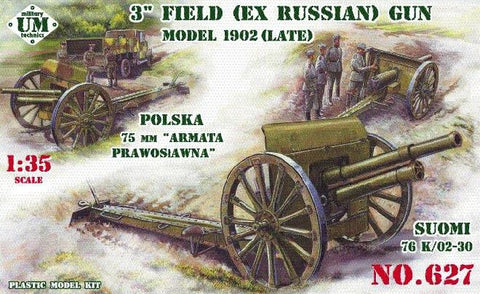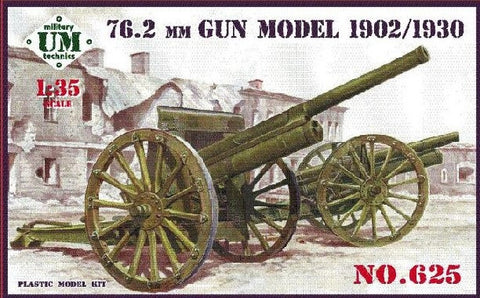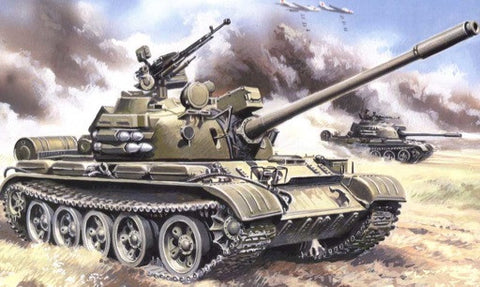
Unimodel Military 1/72 Bison SdKfz 138/M1 Late Tank w/150mm SiG33 Self-Propelled Gun Kit
Estimated Shipping: 2-3 Business Days
UNM-346The Marder III is the name for a series of World War II tank destroyers built on the chassis of the Panzer 38(t). The German word Marder means "marten" in English. They were in production from 1942 to 1944 and served on all fronts until the end of the war. Even in the early stages of Operation Barbarossa, the Wehrmacht already felt the need for a more mobile and more powerful anti-tank solution than the existing towed anti-tank guns such as Pak 36 or tank destroyers like the Panzerjäger I. This need became urgent in June 1941, when anti-tank shells failed to penetrate the armor of new Soviet tanks like the T-34 and KV-1.
As an interim solution, it was decided to use captured French vehicles like the Lorraine (Marder I), obsolete tanks such as German Panzer II (Marder II), and Czech-supplied Panzer 38(t) (Marder III) as the base for makeshift tank destroyers.
As an interim solution, it was decided to use captured French vehicles like the Lorraine (Marder I), obsolete tanks such as German Panzer II (Marder II), and Czech-supplied Panzer 38(t) (Marder III) as the base for makeshift tank destroyers.
Marder III Ausf. H.2C_Sd.Kfz. 138
The next variant of the Marder III fielded the standard 7.5 cm PaK 40 German anti-tank gun on a slightly modified Panzer 38(t) Ausf. H chassis. This chassis had the engine still in the rear of the vehicle but, unlike the previous model, this vehicle utilized the fighting compartment of Panzer 38 in the center. Center compartment allowed crew to stay low in the center of the vehicle, lowering crew exposure to small arms fire and fragments. But because of the rear-mounted engine, there was only enough room for two men to stand in the center. Large side armors gave additional protection for the crew. However, the horseshoe shape armor thinly protected front and side only. The rear and the top were exposed. Thirty-eight rounds of ammunition for the gun were carried. As with the Sd.Kfz.139, this vehicle also carried a 7.92 mm machine gun in the hull, of Czech manufacture.
The last Marder III variant was based on the Geschützwagen 38(t) Ausf. M, a purpose-designed vehicle for self-propelled gun usage, again armed with the 75 mm PaK 40 anti-tank gun. Ausf. M was the final variant of the Marder series and was a significant improvement over previous models, with its lower silhouette, sloped armor and much more functional fighting compartment. In this variant, the engine was moved from the rear to the middle between driver and the rest of the crew. Because there was no engine in the rear, the gun and the crew did not have to sit on top of the engine deck as in previous models. The fighting compartment could be lowered down to the bottom floor level where the engine used to be. This decreased crew exposure, as well as visibility. Unlike the previous two Marder IIIs, the fighting compartment was closed at the rear protecting the crew up to their midsection. It stayed open-topped. It could only carry 27 rounds of ammunition. The machine gun port at the front was eliminated in the Ausf. M in favor of an MG 34 or MG 42 carried by the crew. In the previous two models, the commander served as a gunner. However, in Ausf. M, the radio man moved to the rear with the commander and gunner, serving as a loader. Combat effectiveness increased because the vehicle commander was freed from manning the gun.
The full name of the Ausf. M was Panzerjäger 38(t) mit 7.5 cm PaK 40/3 Ausf. M, Sd.Kfz. 138. It was the variant which was produced in the largest numbers, in total 942 vehicles were built in two series from May 1943 to May 1944. Chassis numbers were 2166–2600 and 2601–3600 (overlapping with simultaneous Grille and Flakpanzer 38(t) production).
The full name of the Ausf. H was the 7.5 cm PaK 40/3 auf Panzerkampfwagen 38(t) Ausf. H,Sd.Kfz. 138. a total of 275 vehicles were built in two series from November 1942 to April 1943. An additional 175 vehicles were converted from Panzer 38(t)'s in 1943. Chassis numbers of new vehicles were 1751–2075 and 2121–2147 (overlapping with simultaneous Grille production).
Marder III Ausf. M, Sd.Kfz. 138The last Marder III variant was based on the Geschützwagen 38(t) Ausf. M, a purpose-designed vehicle for self-propelled gun usage, again armed with the 75 mm PaK 40 anti-tank gun. Ausf. M was the final variant of the Marder series and was a significant improvement over previous models, with its lower silhouette, sloped armor and much more functional fighting compartment. In this variant, the engine was moved from the rear to the middle between driver and the rest of the crew. Because there was no engine in the rear, the gun and the crew did not have to sit on top of the engine deck as in previous models. The fighting compartment could be lowered down to the bottom floor level where the engine used to be. This decreased crew exposure, as well as visibility. Unlike the previous two Marder IIIs, the fighting compartment was closed at the rear protecting the crew up to their midsection. It stayed open-topped. It could only carry 27 rounds of ammunition. The machine gun port at the front was eliminated in the Ausf. M in favor of an MG 34 or MG 42 carried by the crew. In the previous two models, the commander served as a gunner. However, in Ausf. M, the radio man moved to the rear with the commander and gunner, serving as a loader. Combat effectiveness increased because the vehicle commander was freed from manning the gun.
The full name of the Ausf. M was Panzerjäger 38(t) mit 7.5 cm PaK 40/3 Ausf. M, Sd.Kfz. 138. It was the variant which was produced in the largest numbers, in total 942 vehicles were built in two series from May 1943 to May 1944. Chassis numbers were 2166–2600 and 2601–3600 (overlapping with simultaneous Grille and Flakpanzer 38(t) production).






